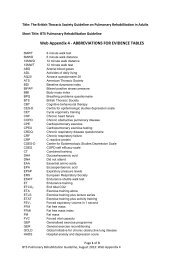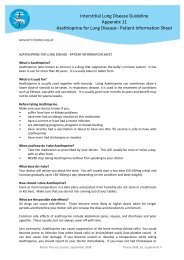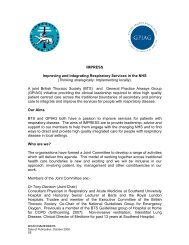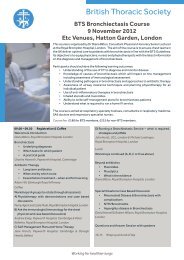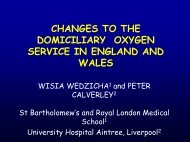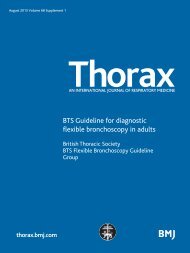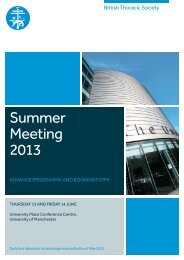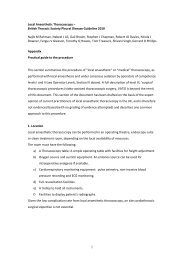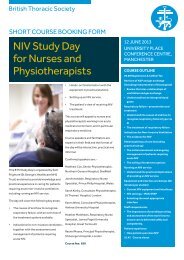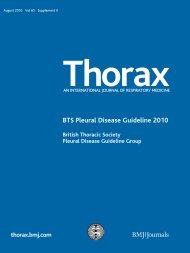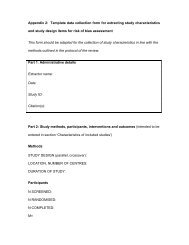Guidelines for the management of community ... - Brit Thoracic
Guidelines for the management of community ... - Brit Thoracic
Guidelines for the management of community ... - Brit Thoracic
You also want an ePaper? Increase the reach of your titles
YUMPU automatically turns print PDFs into web optimized ePapers that Google loves.
BTS guidelines<br />
c<br />
c<br />
Pneumonia caused by atypical pathogens clears more<br />
quickly than pneumonia caused by bacterial infection. [III]<br />
Radiological resolution is slower in elderly patients and<br />
where <strong>the</strong>re is multilobar involvement. [Ib]<br />
5.6 When should <strong>the</strong> chest radiograph be repeated during<br />
recovery and what action should be taken if <strong>the</strong> radiograph has<br />
not returned to normal?<br />
Repeat chest radiographs are probably <strong>of</strong>ten ordered unnecessarily<br />
following CAP. 180 [IVa] Although it has become usual practice<br />
to repeat <strong>the</strong> chest radiograph on hospital discharge and again at<br />
‘‘routine’’ hospital clinic follow-up at around 6 weeks later,<br />
<strong>the</strong>re is no evidence on which to base a recommendation<br />
regarding <strong>the</strong> value <strong>of</strong> this practice in patients who have<br />
o<strong>the</strong>rwise recovered satisfactorily.<br />
The main concern is whe<strong>the</strong>r <strong>the</strong> CAP was a complication <strong>of</strong><br />
an underlying condition such as lung cancer. This concern will<br />
depend on a variety <strong>of</strong> factors such as age, smoking status, preexisting<br />
conditions such as COPD and <strong>the</strong> clinical condition <strong>of</strong><br />
<strong>the</strong> patient. In a study <strong>of</strong> 236 adults presenting to <strong>the</strong>ir general<br />
practitioner with a clinical diagnosis <strong>of</strong> CAP, 10 were found to<br />
have underlying lung cancer on investigation. There was a high<br />
frequency <strong>of</strong> lung cancer in older smokers (6 <strong>of</strong> 36 (17%)<br />
smokers aged .60 years), suggesting that a chest radiograph<br />
was particularly indicated in this group <strong>of</strong> patients with CAP in<br />
<strong>the</strong> <strong>community</strong>. 23 [II] Studies <strong>of</strong> CAP in hospital <strong>of</strong>ten exclude<br />
patients found to have lung cancer, making it difficult to assess<br />
how frequently lung cancer presents acutely with CAP. In one<br />
study <strong>of</strong> 162 adults hospitalised with suspected CAP, <strong>the</strong><br />
diagnosis was accepted in only 127, 10 (6%) <strong>of</strong> <strong>the</strong> 162 being<br />
found to have cancer. 36 [II] Ano<strong>the</strong>r study found only 13 (1.3%)<br />
<strong>of</strong> 1011 patients hospitalised with CAP to have an underlying<br />
lung cancer on investigation. 181 [III] Eight <strong>of</strong> <strong>the</strong>se were detected<br />
on <strong>the</strong> admission chest radiograph and <strong>the</strong> o<strong>the</strong>rs were detected<br />
because <strong>of</strong> unsatisfactory clinical recovery. They concluded that<br />
a convalescent radiograph was useful in detecting occult lung<br />
cancer only if signs or symptoms persisted after a month or so.<br />
The practice <strong>of</strong> per<strong>for</strong>ming bronchoscopy in patients<br />
admitted to hospital with CAP prior to hospital discharge has<br />
been investigated. 182 [III] In patients aged .50 years or who were<br />
current or ex-smokers, 14% were found to have an abnormality<br />
at bronchoscopy (11% had a bronchial carcinoma diagnosed).<br />
Recommendations<br />
c The chest radiograph need not be repeated prior to<br />
hospital discharge in those who have made a satisfactory<br />
clinical recovery from CAP. [D]<br />
c A chest radiograph should be arranged after about<br />
6 weeks <strong>for</strong> all those patients who have persistence <strong>of</strong><br />
symptoms or physical signs or who are at higher risk<br />
<strong>of</strong> underlying malignancy (especially smokers and<br />
those aged .50 years) whe<strong>the</strong>r or not <strong>the</strong>y have been<br />
admitted to hospital. [D]<br />
c Fur<strong>the</strong>r investigations which may include bronchoscopy<br />
should be considered in patients with persisting<br />
signs, symptoms and radiological abnormalities at<br />
around 6 weeks after completing treatment. [D]<br />
c It is <strong>the</strong> responsibility <strong>of</strong> <strong>the</strong> hospital team to arrange<br />
<strong>the</strong> follow-up plan with <strong>the</strong> patient and <strong>the</strong> general<br />
practitioner <strong>for</strong> those patients admitted to hospital<br />
(see Section 7.5). [D]<br />
5.7 What general investigations should be done in a patient with<br />
suspected CAP in <strong>the</strong> <strong>community</strong>?<br />
General investigations are per<strong>for</strong>med to assess severity (see<br />
Section 6), to assess <strong>the</strong> impact on or to detect <strong>the</strong> presence <strong>of</strong><br />
any comorbid disease, to provide some pointer to <strong>the</strong> particular<br />
aetiological agent or group <strong>of</strong> pathogens, identify complications<br />
and to monitor progress (see Section 9).<br />
It may be appropriate to per<strong>for</strong>m investigations in selected<br />
patients, especially if <strong>the</strong>re is delayed improvement on review.<br />
However, no firm recommendations can be <strong>of</strong>fered. It is a<br />
matter <strong>of</strong> clinical judgement.<br />
Recommendations<br />
c General investigations are not necessary <strong>for</strong> <strong>the</strong><br />
majority <strong>of</strong> patients with CAP who are managed in<br />
<strong>the</strong> <strong>community</strong>. [C] Pulse oximeters allow <strong>for</strong> simple<br />
assessment <strong>of</strong> oxygenation. General practitioners,<br />
particularly those working in out-<strong>of</strong>-hours and emergency<br />
assessment centres, should consider <strong>the</strong>ir use<br />
(see Section 7.1). [D]<br />
c Pulse oximetry should be available in all locations<br />
where emergency oxygen is used. [D]<br />
5.8 What general investigations should be done in patients<br />
admitted to hospital?<br />
Apart from <strong>the</strong> chest radiograph essential <strong>for</strong> diagnosis, <strong>the</strong> only<br />
o<strong>the</strong>r simple non-microbiological tests that influence immediate<br />
<strong>management</strong> are <strong>the</strong> urea, which in<strong>for</strong>ms severity assessment,<br />
and oxygen saturation, which affects supportive <strong>management</strong><br />
and track and trigger systems in accordance with <strong>the</strong> BTS<br />
guideline <strong>for</strong> emergency oxygen use in adult patients. 183<br />
In addition, it is normal practice to take blood <strong>for</strong> a full blood<br />
count, urea and electrolytes, liver function tests and CRP. These<br />
<strong>of</strong>ten help to identify important underlying or associated<br />
pathologies including renal or hepatic disease and haematological<br />
or metabolic abnormalities.<br />
A white cell count <strong>of</strong> .15610 9 /l strongly implicates a<br />
bacterial (particularly pneumococcal) aetiology, although lower<br />
counts do not exclude a bacterial cause. 184 [III] A white cell count<br />
<strong>of</strong> .20610 9 /l or ,4610 9 /l is an indicator <strong>of</strong> severity (see Section<br />
6).<br />
Considering <strong>the</strong> role <strong>of</strong> CRP in <strong>the</strong> diagnosis <strong>of</strong> CAP, a<br />
prospective study per<strong>for</strong>med in Spain reported a 96% specificity<br />
<strong>for</strong> CAP using a threshold CRP level <strong>of</strong> .100 mg/l. 185 [II]<br />
Criticisms <strong>of</strong> this study are <strong>the</strong> small number <strong>of</strong> patients in<br />
one group and <strong>the</strong> fact that patients with infective exacerbations<br />
<strong>of</strong> COPD were excluded. Ano<strong>the</strong>r study showed that a<br />
raised CRP level on admission is a relatively more sensitive<br />
marker <strong>of</strong> pneumonia than an elevated temperature or raised<br />
white cell count. All patients with CAP had CRP levels .50 mg/l<br />
and 75% <strong>of</strong> patients had levels .100 mg/l. 186 [II] In <strong>the</strong> same paper<br />
it was reported that a CRP level <strong>of</strong> .100 mg/l helped to<br />
distinguish CAP from acute exacerbations <strong>of</strong> COPD. Ano<strong>the</strong>r<br />
group found that only 5% <strong>of</strong> patients admitted with CAP had<br />
CRP levels ,50 mg/l. 187 [III] Although not yet widely available, a<br />
bedside finger-prick CRP test has been used to predict CAP in 168<br />
patients presenting with acute cough and, at a cut-<strong>of</strong>f <strong>of</strong> 40 mg/l,<br />
was found to have a sensitivity <strong>of</strong> 70% and a specificity <strong>of</strong> 90%<br />
independent <strong>of</strong> any clinical characteristics. 188 [II] CRP levels are<br />
generally higher in patients who have not received antibiotic<br />
186 [II]<br />
<strong>the</strong>rapy be<strong>for</strong>e admission.<br />
With regard to predicting <strong>the</strong> microbial aetiology <strong>of</strong> CAP,<br />
higher CRP levels have been associated with pneumococcal<br />
Thorax 2009;64(Suppl III):iii1–iii55. doi:10.1136/thx.2009.121434<br />
iii19



